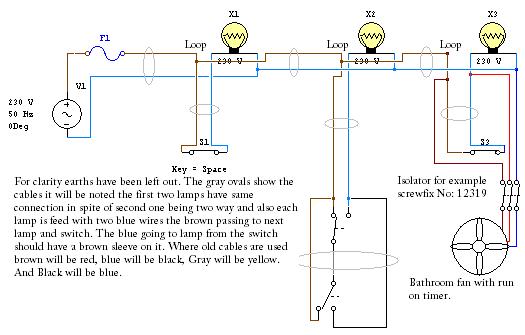As to if coming on with light is automatic is open for debate! But I would consider in rooms with natural light at least the switch would need a label!
Personally, I wouldn't class that as automatic, since it requires the operation of a switch (albeit a switch which also controls the light) to turn the fan and off. I would class automatic operation as being when the fan is triggered into operation by a humidity sensor, motion sensor, or something similar.
OK it does not say from what point but I would think most people would say from leaving room.
But then you can debate over what triggers that 15-minute period from leaving the room. If the bathroom has no natural light and you link the timer fan to the light switch, then it's reasonable to asume that the light will be switched off as the person leaves, hence the timer period starts at that point. But what if the fan is switched independently, whether the bathroom has natural light or not? If we take it that the 15-minute over-run is supposed to be from leaving the room, there would then be nothing to stop a person blipping the switch on & off as he enters, spending 10 minutes in the bathroom, then the fan will run for only another 5 minutes after he leaves. And seeing as with independent switching (or linked to the light but in a bathroom with its own natural light) there's nothing to stop the person going in there from not switching on the fan at all, the whole "requirement" in the Approved Document seems pretty pointless.
I suppose a push button that you press on entering would comply but real point is would LABC see it that way?
Depends how willing somebody is to capitulate to the council gestapo agent's personal agenda, I suppose. If it were my house I was building, I'd argue all the way that the Building Regs. give them absolutely no authority to demand a timer fan, however it's operated.
So many of these petty demands are stupid anyway. Even if somebody gives in and fits a timer fan set to 15 minutes, do these people really think that home owners aren't just going to take the cover off after the inspector has gone and adjust the timer to something more reasonable, or disable the timer completely?
In rooms with no natural light, the fans could be controlled by the operation of the main room light switch.
I would consider the reverse must also be true as a room with natural light needs control with other than main room light.
That's one more reason why for myself I would always wire the fan completely independently from the light, but even if one were to apply the guidelines in the Approved Document, I don't see anywhere which stipulates that. The only requirement listed is that the fan is operated either automatically or manually, and that if automatic then a manual override should be provided. Nothing says that the manual switching/override cannot also operate a light in parallel.
This leads back to your first point about automatic vs. manual, but in fact I think the Approved Document itself rather settles that question. As it suggests that a timer fan
could be operated from the light, and LABC inspectors seem to accept that arrangement, then for the purposes of the Approved Document that must amount to manual switching, surely? If it were to be classed as automatic by virtue of the fan coming on with the light, then there would need to be a separate fan-only override switch.
Except for kitchens which must have automatic control
Where is there anything which says that?
one can have manual control so I don't understand why we have all the complication of linking with lights when a plain on/off switch at entrance would do?
I don't either. Linking a timer fan to the light means that the fan is often running completely unnecessarily when somebody just goes into the bathroom for a minute, and then continues to run equally unnecessarily for several minutes after he leaves. Or in a room with natural light, it means that the light is burning away needlessly in broad daylight if somebody takes a bath or shower and wants to run the exhaust fan. I thought we were supposed to be
conserving energy, not wasting it?
So it does seem as if only lip service is paid to Part F and the document is really more use as loo paper.
That goes for 99% of the paperwork the government churns out......



